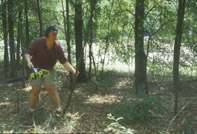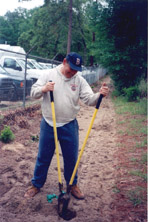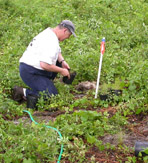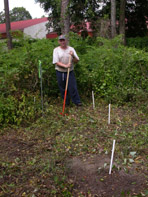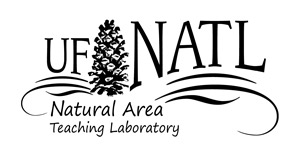| UF Academic Use | Public Use | Family Fun and K-12 Education |

Ken Prestwich
NATL’s First Super Volunteer
Kenneth N. Prestwich received his PhD in UF's Zoology Department in 1981 and is now an Associate Professor in the Biology Department of the College of the Holy Cross in Worcester, Massachusetts. Every year, since before the start of NATL, Ken has returned to UF for a month to six weeks in May and June to do research on cricket physiology in Tom Walker’s laboratory in the Entomology and Nematology building. For more about Ken's research and other interests go to his home page.
Every year, while Ken is in Gainesville, he spends much time working to improve NATL. In fact, almost every weekday he works there for at least an hour. Below are images and text that describe some of Ken's contributions to NATL.
1995–1997
Ken girdled laurel oaks in the north block of the public-area upland pine and planted wiregrass and upland-pine forbs in both blocks of public-area upland pine.
1998–2001
1999
In 1998–99, as docents from the Florida Museum of Natural History guided groups of grade-school students through NATL, the youngsters were often distracted by activities in the Division of Plant Industry compound. A wax myrtle hedge was settled upon as a solution to this problem, and FLMNH secured the donation of the needed plants. On the agreed-upon Saturday morning in May, when volunteers were to plant the hedge, only three showed up. Two of the three were Ken and his wife, Cathy Langtimm. These two did nearly all the hard work of planting about 100 wax myrtles. |
2002
Having completed his work on the Prestwich tract, Ken moved his assault on laurel oaks to the south block of the restricted-area upland pine.
2003
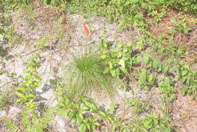 |
In late May to early July, Ken planted, or helped plant, this and all but 43 of the other 247 grass-stage-or-better longleaf pines that were transplanted to the public-area upland pine in 2003. |
2004
In May and June, Ken planted or helped plant all of the 295 clumps of wire grass transplanted to the public-area upland pine that year. He also did much of the work in planting, mulching and watering of 15 trees native to NATL in the eastern half of Natural Area Park. |
2005
| In the early summer of 2005, Ken used a fire rake to clear most of 48 "restoration islands" in the public-area upland pine. Each island was at least ten feet in diameter and provided sites where six small longleaf pines were to be planted, monitored, and cared for for at least three years. (About 90% of the 248 small longleafs planted in 2003 survived through the spring of 2004 and yet fewer than 10% could be found six months later!) The islands were to be kept mostly free of vegetation to provide a good substrate for natural germination of longleaf pine seeds and for establishing wiregrass to be planted as plugs in the summer of 2006. Having cleared the islands, Ken then helped populate them with a total of 288 grass stage and ready-to-shoot pines. In late November, Ken returned to Gainesville for a portion of his sabbatical and worked in the public-area upland pine cutting tall brush and treating the stumps with Garlon. |
Ken's involvement with NATL actually started in the spring of 1993 when he was one of a group of about fifteen faculty and interested others who toured what would eventually become NATL and agreed that they should propose that the area be designated a "Campus Natural Area and Outdoor Teaching Laboratory" in the upcoming first UF Master Plan. And Ken's involvement has continued beyond the date in December when the first version of this document was drafted in support of Ken being named NATL's first Super Volunteer.—Tom Walker, May 2006.
